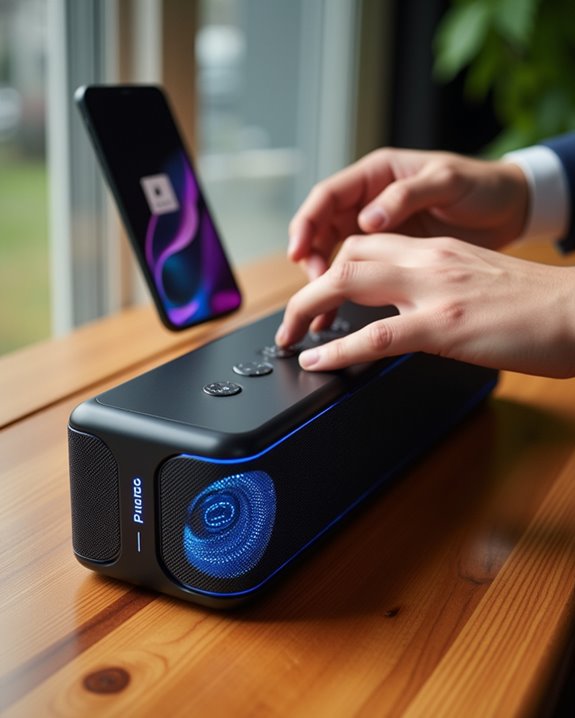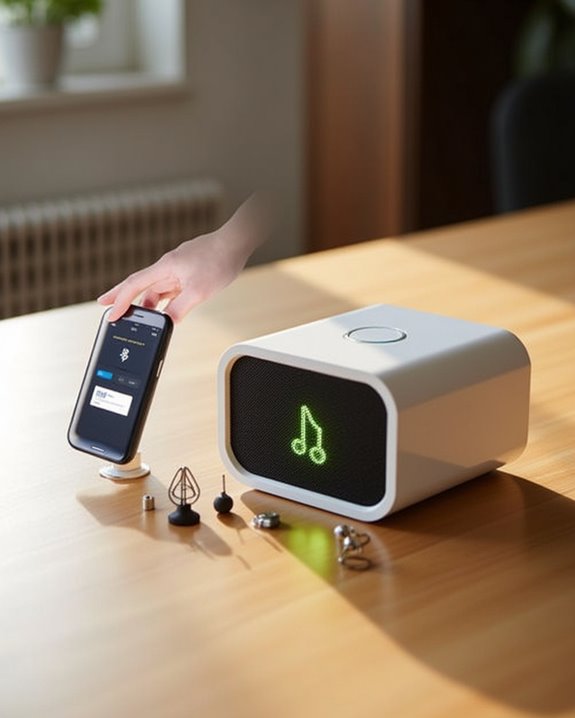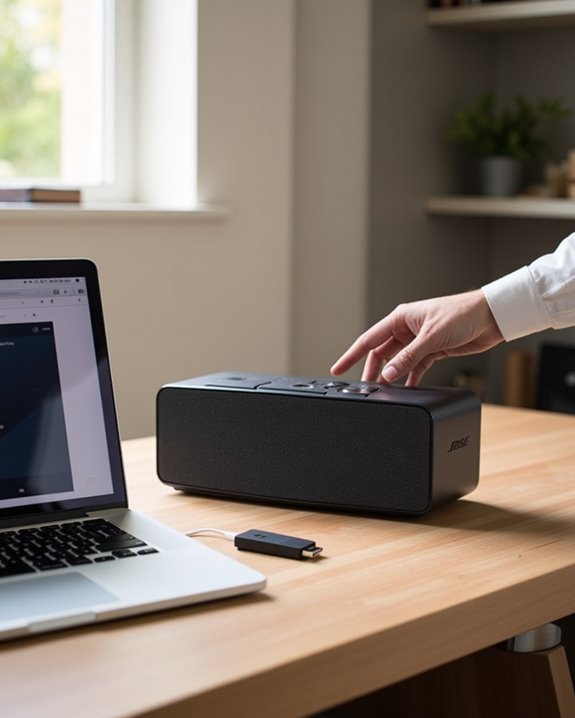To connect an Akai Bluetooth speaker, first charge the 7.4V 3000mAh lithium-ion battery using the included USB cable until the red LED extinguishes, indicating full charge. Power on the speaker via its side or top ON/OFF switch; a flashing blue LED signals Bluetooth pairing mode within a 10-meter range. On a smartphone or tablet, activate Bluetooth, select the device identifier (e.g., A58071), and enter the default PIN “0000” if prompted. A solid blue LED confirms successful pairing and stable Bluetooth 5.0 connectivity, enabling up to seven hours of wireless playback at 50% volume. Further details include operational controls, troubleshooting tips, and maintenance guidelines.
Key Takeaways
- Power on the Akai Bluetooth speaker using the ON/OFF switch; a flashing blue LED indicates it is in pairing mode.
- Enable Bluetooth on your smartphone or tablet and select the speaker name, such as “A58071” or “AKAI ABTS-21H,” from the device list.
- Enter the default pairing PIN “0000” if prompted to establish a secure Bluetooth connection.
- Confirm successful pairing when the speaker’s blue LED changes from flashing to solid.
- Maintain device range within 10 meters for optimal Bluetooth 5.0 connectivity and uninterrupted audio playback.
Preparing Your Akai Bluetooth Speaker
The preparation phase for the Akai Bluetooth speaker involves several critical steps to guarantee ideal functionality and longevity. Initially, the portable speaker should be removed from all packaging to facilitate an unobstructed setup. Charging is conducted via the USB port using the supplied cable connected to a DC 5V source; a full charge requires approximately 6.5 hours. During charging, the red LED illuminates, indicating active power intake, and extinguishes once the battery is fully charged. This lithium-ion battery, rated at 7.4V and 3000mAh, supports up to 7 hours of playback at 50% volume. Upon power activation, the blue LED flashes, signaling readiness for BLUETOOTH connection. Adhering to these preparatory guidelines guarantees ideal battery performance and device reliability prior to BLUETOOTH pairing. Additionally, ensuring the battery management system is functioning properly can extend the overall lifespan of the device.
Powering On and Entering Pairing Mode

The power button on Akai Bluetooth speakers, typically located on the side or top panel, serves as the primary control for activating Bluetooth mode, with models like the A58071 employing an ON/OFF switch and others such as the ABTS-70 using a press-and-hold mechanism. Upon activation, the device enters pairing mode, indicated by a flashing blue LED that signals readiness to connect within an approximate 10-meter range, ensuring efficient device detection. These visual pairing indicators provide immediate feedback, enhancing user experience by confirming operational status and facilitating seamless synchronization with compatible Bluetooth-enabled devices.
Power Button Location
Locating the power button on Akai Bluetooth speakers involves identifying the ON/OFF switch positioned among the device’s connectivity ports, including the DC/micro USB port, AUX port, and TF card slot. The button to turn the speaker on is typically a sliding switch or a physical MODE BUTTON, designed for ease of access. When switched ON, the Bluetooth mode activates automatically, signaled by a flashing blue LED light acting as an indicator light to confirm pairing readiness. Models such as ABTS-21H and ABTS-70 incorporate a power button that, when pressed and held, initiates Bluetooth pairing mode within a 10-meter range. The LED indicator changes from flashing to solid blue upon successful connection, providing clear visual feedback. This design guarantees straightforward operation for users seeking reliable wireless audio connectivity.
Activating Bluetooth Mode
Activating Bluetooth mode on Akai speakers requires engaging the ON/OFF switch, which powers the device and initiates a Bluetooth readiness announcement accompanied by a flashing blue LED, signaling pairing availability. On certain models, a short press or press-and-hold of the power button shifts the speaker into Play Mode, where the speaker will beep, confirming activation. This Portable Bluetooth speaker then broadcasts its identification, such as “A58071” or “AKAI ABTS-21H,” allowing the Bluetooth device or mobile device to detect and pair within a typical 10-meter range. Once connected, users can play music seamlessly. If prompted, entering the default password “0000” completes the pairing process. These activation steps guarantee reliable connectivity and ease of use across varied Akai speaker models.
Pairing Indicator Signals
A distinct visual indicator is employed across Akai Bluetooth speaker models to confirm successful power-on and initiation of pairing mode, primarily through a flashing blue LED. For instance, the A58071 model’s ON/OFF switch activation triggers a blue LED flash, signaling pairing readiness, while the ABTS-21H’s power button initiates Bluetooth mode accompanied by a blinking LED. The ABTS-70 requires holding the power button to enter pairing mode, with the LED flashing to indicate device search within a 10-meter unit away. These PORTABLE SPEAKER units use the Bluetooth® word mark and logos—trademarks owned by Bluetooth SIG—to authenticate wireless connectivity, maintaining channel emission power within regulatory limits. The flashing blue LED, a registered trademark indicator, guarantees users recognize the device’s active pairing state, optimizing connection reliability and user experience.
Connecting via Smartphone or Tablet
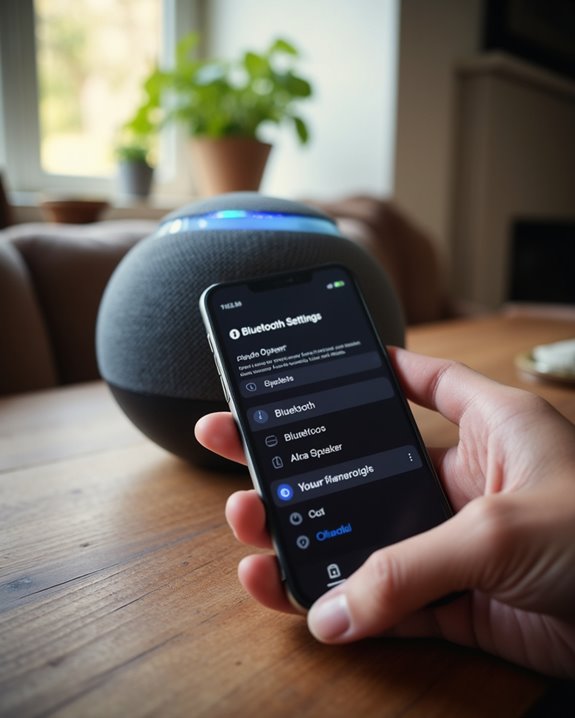
When powering on the Akai Bluetooth speaker by switching it to the ON position, the device emits an auditory readiness notification and activates a flashing blue LED, signaling its availability for pairing. To connect via smartphone or tablet, access the Bluetooth settings and select the speaker’s identifier, such as “A58071” or “AKAI ABTS-21H,” ensuring the device remains within a 10-meter radius for ideal signal strength. If prompted, enter the default PIN “0000” to secure the connection. Upon successful pairing, the blue LED becomes solid. Speaker users can then play music directly from their device, including music with heavy bass, while maintaining the connection during charging. It’s also helpful to verify that your device supports the Bluetooth 5.0 standard for optimal performance. Please put the volume at a moderate level to preserve audio fidelity and battery longevity before proceeding to the next usage guidelines.
Using the Bluetooth Features and Controls
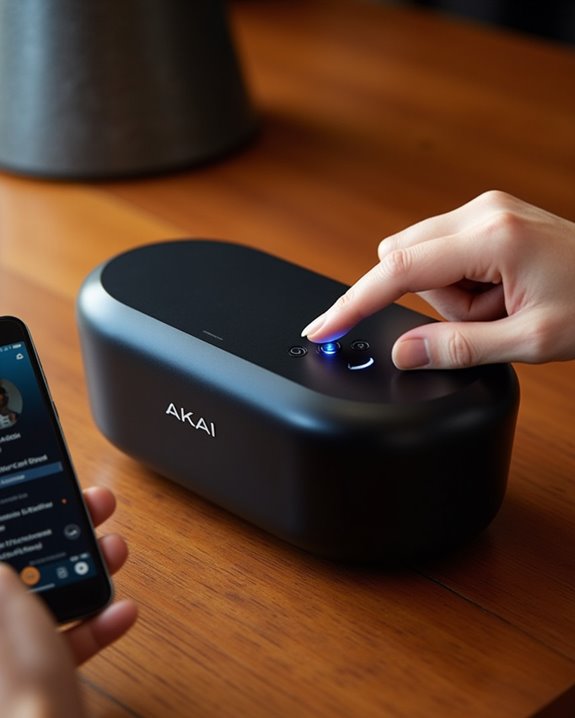
Activating Bluetooth on the Akai speaker involves switching the device on, which initiates pairing mode indicated by a flashing blue LED, allowing connection to devices within a 10-meter range using the identifier “A58071” and a standard PIN “0000.” Playback controls include a dedicated play/pause button on the speaker, enabling users to manage audio without accessing the connected device directly, enhancing user convenience. Connection status is visually communicated through LED indicators, with a solid blue light confirming a stable Bluetooth 5.0 link, ensuring reliable wireless performance and seamless device management. To ensure optimal performance, selecting a speakers with Bluetooth 5.0 or higher can provide a more reliable connection and better range.
Pairing the Speaker
Although initiating Bluetooth pairing varies slightly among Akai speaker models, the process generally involves switching the device to Bluetooth mode, which is visually confirmed by a flashing blue LED indicator signaling readiness. Users typically activate pairing by flipping the ON/OFF switch or pressing the power button, as seen in models like A58071 and ABTS-21H. The device name appears on the Bluetooth-enabled device within a 10-meter range, requiring the password “0000” if prompted for secure connection. It is advisable to avoid interference, ensuring the speaker can afford the high current temporarily needed for stable signal transmission. Akai speakers, compatible with SD/TF card inputs, maintain compliance with Wi-Fi Alliance and registered trademarks owned, though Bluetooth pairing operates independently from Wi-Fi® word mark protocols. Power bank compatibility supports portable use, albeit temporarily under the maximum current specifications.
Using Playback Controls
A complete set of playback controls is integrated into the Akai Bluetooth speaker to facilitate seamless audio management directly on the device, enhancing user convenience during wireless streaming. The play/pause button enables users to start, pause, or resume music streaming without accessing the connected device. Volume control is managed via dedicated buttons, allowing precise adjustments during Bluetooth playback. Skip tracks functions are accessible through forward and backward buttons, ensuring efficient navigation across playlists. LED indicators provide real-time feedback: a flashing blue light denotes pairing mode, while a solid blue confirms active connection and playback. Additionally, speaker controls include a phone button for hands-free calls, integrating mobile communication seamlessly. These features collectively optimize the user experience by consolidating music streaming and call management within a compact interface.
Managing Bluetooth Connections
When the Akai Bluetooth speaker’s power switch is toggled to the ON position, the device immediately enters pairing mode, indicated by a flashing blue LED and an audible announcement confirming readiness to connect. Users can then locate the speaker’s identifier, such as “A58071” or “AKAI ABTS-21H,” within their device’s Bluetooth settings, entering the default password “0000” if prompted. The solid blue LED confirms a successful connection, enabling seamless audio streaming without requiring an audio cable. The integrated play/pause button allows users to manage calls and music directly, helping to protect device longevity by reducing physical wear. Utilizing the TWS feature to pair two speakers wirelessly can prolong the life of the product and protect the environment by minimizing additional hardware needs. The symbol on the product or packaging means it meets standards designed to prevent electronic waste.
Playing Music Through Your Akai Speaker
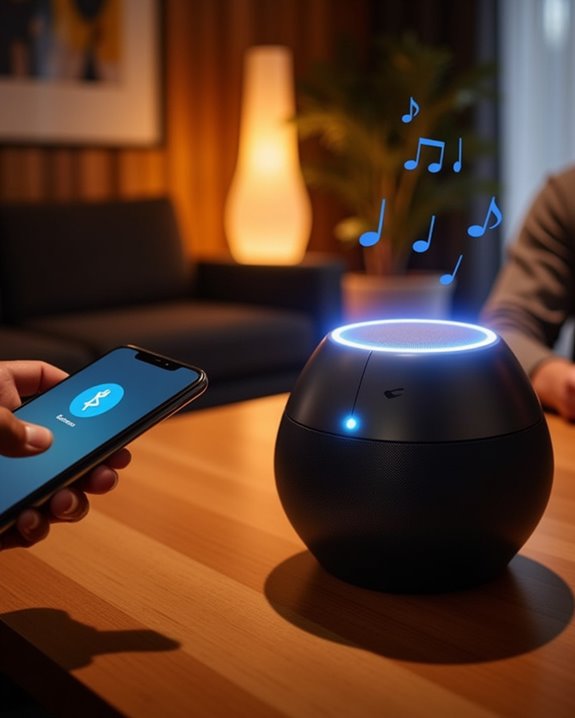
Once paired with a compatible device via Bluetooth 5.0, the Akai Bluetooth speaker enables seamless music playback within an effective range of 10 meters, ensuring minimal signal degradation. Users can select the Akai speaker as the audio output to initiate playback, utilizing the play/pause button to control music conveniently. Additionally, the speaker supports micro SD card insertion into the TF slot for automatic track playback, with skip controls enhancing navigation. In USB play mode, connecting a USB drive allows direct music streaming, benefiting from the built-in 7.4V / 3000mAh lithium battery that provides up to 7 hours of playback at 50% volume. Volume adjustment is managed via short presses on the forward/backward buttons, optimizing sound clarity while preserving battery life and preventing distortion during extended use.
Troubleshooting Connection Issues
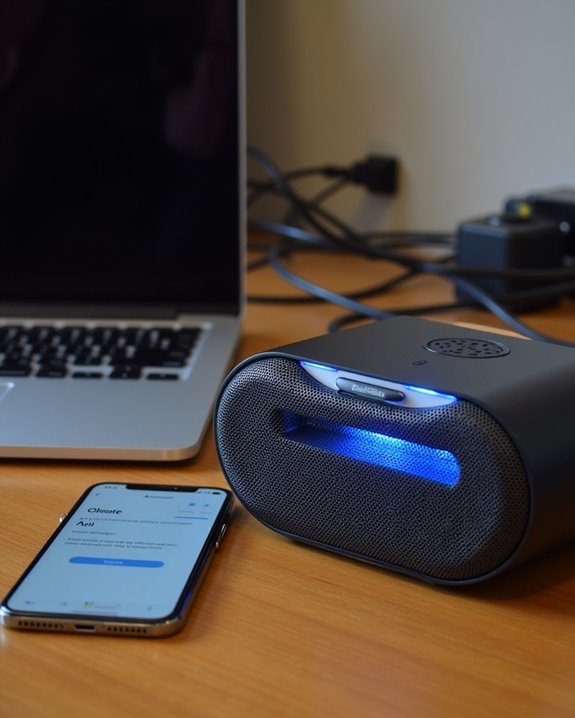
Although the Akai Bluetooth speaker incorporates advanced Bluetooth 5.0 technology to facilitate stable wireless connections within a 10-meter effective range, occasional pairing issues may arise due to various factors. Users should verify Bluetooth pairing mode is active, indicated by a flashing Blue LED, confirming readiness for device connection. Accurate device name recognition, such as “AKAI ABTS-21H” or “A58071,” is essential for successful pairing. Range interference from electronic devices and environmental factors like high humidity may disrupt connectivity. LED indicators assist in identifying operational modes, ensuring the speaker is not in auxiliary or USB mode. When prompted for a Password, entering “0000” enables proper authentication. Adhering to these protocols optimizes Bluetooth V5.0 performance, reducing connection failures and enhancing user experience.
Maintaining and Charging Your Akai Speaker
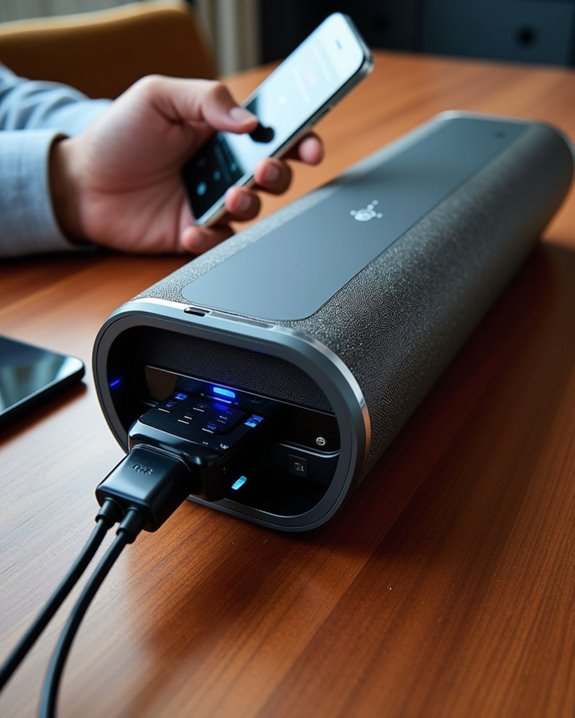
Regular maintenance and proper charging protocols are essential to optimize the performance and longevity of the Akai Bluetooth speaker. Charging should be performed using the included USB cable connected to a 5V/1-2A power source, with the Micro USB end inserted into the DC 5V port; full charge requires 2-4 hours, indicated by a red LED indicator that extinguishes upon completion. The 7.4V/3000mAh lithium battery supports up to 7 hours of playtime at 50% volume, necessitating timely charging to preserve battery health. Maintenance involves cleaning the exterior with a soft, damp cloth while avoiding abrasive chemicals to prevent damage. Unplugging the speaker during lightning storms or extended inactivity safeguards against electrical surges, enhancing durability. These technical practices guarantee reliable operation and prolonged device lifespan.
Frequently Asked Questions
How Do I Connect My Akai Speaker to Bluetooth?
The Akai setup involves device linking within Bluetooth range, ensuring best audio quality. Firmware updates enhance sound optimization and battery impact. Users can connect multiple speakers for a multi speaker experience, fostering community through shared music enjoyment.
How Do I Put My Bluetooth Speaker in Pairing Mode?
Over 70% of users find indicator signals essential in pairing steps. Mode activation often involves a button sequence or toggle process via the power method. Light patterns confirm success, while reset technique aids troubleshooting, fostering connection and belonging among users.
Why Is My Bluetooth Not Connecting to My Bluetooth Speaker?
Bluetooth connection failure often results from signal interference, range problems, or device compatibility issues. Battery drain, software glitches, firmware issues, overheating causes, and hardware faults can also disrupt pairing, requiring attention to achieve seamless connectivity and community enjoyment.
How to Connect Bluetooth to Phone?
Traversing invisible bridges fosters connection, yet phone compatibility and Bluetooth versions must align. Signal interference, battery impact, and audio latency subtly influence harmony. Embracing security features, update processes, and multi connectivity nurtures belonging within a seamless digital community.

